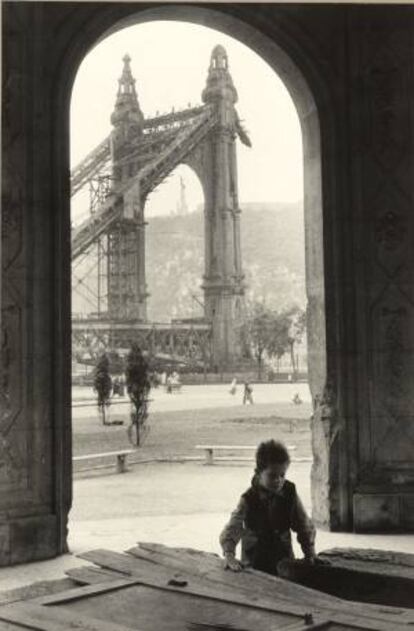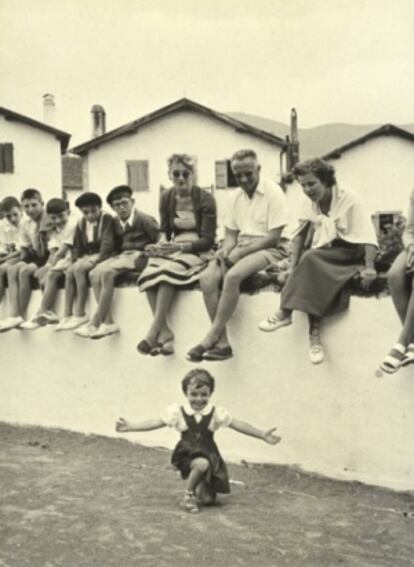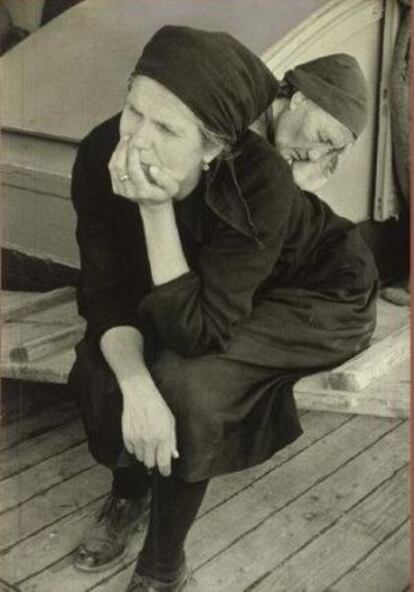Magnum's lost treasure
Madrid space recreates the famous photo agency's first show of 52 years ago

The packing box is the same as those used to store and transport works of art for any exhibition. Time - almost 60 years - has darkened but not destroyed it. Inside, wrapped up with exquisite care, are 83 vintage copies, mounted on cardboard, alongside slips of paper bearing their titles and authors. They are the original images taken by eight photographers from the famous Magnum agency - Werner Bischof, Henri Cartier-Bresson, Robert Capa, Ernst Haas, Erich Lessing, Jean Marquis, Inge Morath and Marc Riboud - which made up the first exhibition of the agency's work.
Titled Magnum photo Gesicht der Zeit (The face of time) the exhibition toured five Austrian cities between June 1955 and February 1956. Afterwards somebody collected together all the material and stored it in one of the storerooms of the Institut Français in Innsbruck, where it remained until 2008, when, by pure coincidence, it was found in perfect condition.
Lorenza Bravetta, director of Magnum Photos for Europe, explains what happened, saying that the process of keeping tabs on works was not so controlled in those days and that something similar could still happen today. "There was no bad intention on anyone's part," she says. "It was a lapse of attention that was happily resolved."
The exhibition is the same as the one that toured Austria in 1955 and 1956
The packaging of the works, alongside the introductory text for the original exhibition and the poster, are the first things you see at the recreation of the show, which goes under the title Magnum's First, now on at Fundación Canal in Madrid. It has previously been seen in Vienna, Hamburg, Munich and Fellbach and after its stop in the Spanish capital will continue traveling around the world.
The exhibition is not only important for being the first by the people who turned photojournalism into an art form, but also because the images are presented in the exact way their authors decided - with the exception of Robert Capa, who died in Vietnam in 1954 (Tuesday marked the 100th anniversary of his birth). The others chose their own series and decided how they wanted them to be exhibited in order to highlight the revolutionary principles Magnum had employed since its foundation in 1947: the photographic eye, the importance of the moment and proximity to the subject, precepts that subverted the way of seeing the world and the idea of the photograph. Enrique Bornet's surprising staging, which recreates a postwar storeroom, invites you to contemplate the works of each artist.

Austrian-born Inge Morath (1923-2002) exhibits the poetic images she took in London's elite Soho and Mayfair districts for Holiday magazine. Opposite these is Robert Capa, who in the 1950s was already famous for his images of war, especially those of the Spanish Civil War. The three snapshots by Capa, chosen by Ernst Haas, were taken in Biarritz in 1951, 14 years after the photographer shook the world with his images of the bombing of Bilbao. They show old and young people alike taking part in local festivities dedicated to dancing and drinking. Capa took them while kneeling on the floor to be faithful to the joy of the children portrayed in them.
Werner Bischof (1916-1954) shows seven photographs of his travels around the world. Some of them, such as the crying Hungarian boy, the solitary flutist in the Andes and the Bombay dancer have become icons of world photography.

The central part of the exhibition is occupied by Henri Cartier-Bresson (1908-2004) and his celebrated report on Mahatma Gandhi from 1948, which many consider the highpoint of world photojournalism. Captured on his Leica, the 18 images narrate the last days, assassination and funeral of Gandhi and were published in Life. Those showing the multitudinous displays of grief at his funeral and the scattering of his ashes are masterpieces that keep the emotion intact for the viewer's eyes.
Known for his images of post-World War II devastation, Erich Lessing (1923-) chooses shots of relaxed and happy children in occupied Vienna, while Ernst Haas shows, in disturbing style, the hell experienced by the 4,000 extras who took part in director and producer Howard Hawks' biblical epic Land of the Pharaohs in 1955 as a result of the terrible desert heat, overcrowding and sand storms.
Jean Marquis (1926-) and Marc Riboud (1923-) close the exhibition with series showing scenes from everyday life. The former with 10 photographs taken in Hungary in 1954; the latter with a dozen shots of solitary figures, among which feature a man dragging an enormous portrait of former Yugoslavian dictator Tito that had just been used at a rally.
Tu suscripción se está usando en otro dispositivo
¿Quieres añadir otro usuario a tu suscripción?
Si continúas leyendo en este dispositivo, no se podrá leer en el otro.
FlechaTu suscripción se está usando en otro dispositivo y solo puedes acceder a EL PAÍS desde un dispositivo a la vez.
Si quieres compartir tu cuenta, cambia tu suscripción a la modalidad Premium, así podrás añadir otro usuario. Cada uno accederá con su propia cuenta de email, lo que os permitirá personalizar vuestra experiencia en EL PAÍS.
¿Tienes una suscripción de empresa? Accede aquí para contratar más cuentas.
En el caso de no saber quién está usando tu cuenta, te recomendamos cambiar tu contraseña aquí.
Si decides continuar compartiendo tu cuenta, este mensaje se mostrará en tu dispositivo y en el de la otra persona que está usando tu cuenta de forma indefinida, afectando a tu experiencia de lectura. Puedes consultar aquí los términos y condiciones de la suscripción digital.
Últimas noticias
Trump clarifies who is ultimately in charge in Venezuela: ‘Me’
Maduro pleads not guilty before the federal court in New York: ‘I am still the president of Venezuela’
A new test can detect Alzheimer’s from a finger prick
UN team enters Sudanese city of El Fasher after paramilitary massacre: ‘It’s like a ghost town’
Most viewed
- Gilles Lipovetsky: ‘If you want to live better and fall in love, take Prozac, don’t look to philosophy’
- Alain Aspect, Nobel laureate in physics: ‘Einstein was so smart that he would have had to recognize quantum entanglement’
- Alvin Hellerstein, a 92-year-old judge appointed by Bill Clinton, to preside over Maduro’s trial in New York
- Why oil has been at the center of Venezuela-US conflicts for decades
- Cuba confirms death of 32 of its citizens in the US attack against Venezuela








































